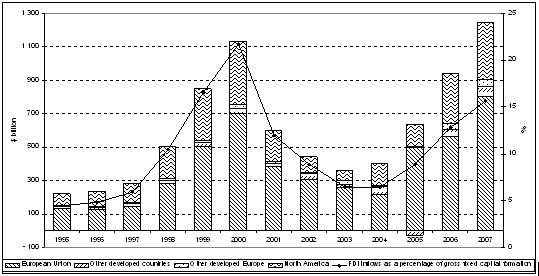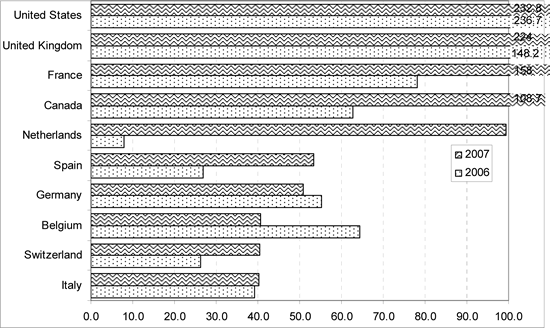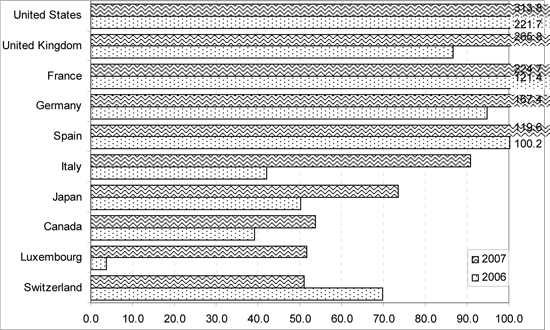| EMBARGO The contents of this press release and the related Report must not be quoted or summarized in the print, broadcast or electronic media before 24 September 2008, 17:00 GMT (13:00 New York, 19:00 Geneva, 22:30 New Delhi, 02:00 - 25 September in Tokyo) |
Geneva, 24 September 2008 - FDI inflows to developed countries surged by 33% in 2007 to a record US$ 1,248 billion (figure 1), according to UNCTAD´s World Investment Report 2008(1) . FDI outflows from these nations grew even faster, to US$ 1,692 billion. This dynamism contrasts with the economic uncertainty faced by some developed economies as the subprime mortgage crisis and related banking difficulties play out, the report says. But it predicts that this financial turmoil will lead to reduced FDI activity in developed countries beginning with 2008.
The year´s edition of UNCTAD´s annual investment survey, subtitled "Transnational Corporations and the Infrastructure Challenge," was released today.
The United States retained its position as the world´s largest recipient of FDI in 2007. Inflows into Canada almost doubled for a second consecutive year, making it the fourth largest recipient (figure 2). Large FDI flows to the United Kingdom, France, the Netherlands, and Spain drove the increase in overall FDI inflows to the European Union (EU) to US$804 billion - a 43% increase - while flows to the 12 new EU member countries remained stable at $65 billion. The enlarged EU experienced a new wave of cross-border acquisitions as a result of the restructuring and consolidation of industries. In Japan, FDI inflows grew strongly in 2007 for the first time since the end of the 1990s.
Transnational corporations (TNCs) from developed countries, benefiting from large corporate profits, accounted for about 90% of the growing number and value of cross-border mega mergers and acquisitions (mega M&As, deals of over US$ 1 billion) in developed countries. But developing-country TNCs were also increasingly active in tapping developed-country markets for corporate assets.
The largest outward investors - the United States, the United Kingdom, France, Germany, and Spain (in that order) - recorded FDI outflows of more than US$ 100 billion each, representing 64% of the total outward FDI of the group (figure 3). The United States maintained its position as the largest outward investor in 2007, with total investments amounting to US$ 314 billion (a 42% increase over 2006). Outward FDI from the EU member countries nearly doubled to US$ 1,142 billion, reflecting the financial strength of the many TNCs in Europe. Several made large foreign acquisitions during the year. The United Kingdom´s investments abroad tripled from 2006 levels, and France was the third largest source of FDI, with investments of US$ 225 billion, followed by Germany and Spain.
The value of cross-border M&As in developed countries rose in the manufacturing and services sectors, but lagged somewhat in the primary sector. Services, which accounted for 58% of all M&As, also continued to attract the largest deals in developed economies in 2007: the US$ 98 billion acquisition of ABN-AMRO Holding NV by the consortium of Royal Bank of Scotland, Fortis, and Santander was the largest deal in banking history. There are, however, growing concerns over the increasing number of cross-border investments by sovereign wealth funds and by private equity and hedge funds.
The policy environment for FDI in the majority of developed countries continues to aim at greater openness, with some exceptions. This was confirmed by the number of regulatory changes that sought to ease flows of FDI in 2007: of the total of 36 changes, 27 were more favourable to the operations of foreign TNCs.
The World Investment Report 2008 predicts that FDI to and from developed countries will decline in the near future because of the dampening effects of the financial market crisis combined with weaker economic growth in developed economies. The value of cross-border M&As in developed countries fell considerably in the first half of 2008 compared with the second half of 2007. In UNCTAD´s World Investment Prospects Survey 2008-2010, 39% of responding TNCs anticipated an increase in FDI inflows into developed countries compared with more than 50% in last year´s survey.
The World Investment Report and its database are available online at http://www.unctad.org/wir and http://www.unctad.org/fdistatistics |
ANNEX
Tables and figures
Figure 1. Developed countries: FDI inflows in value and as a percentage of gross fixed capital formation, 1995-2007
Source: UNCTAD, World Investment Report 200: Transnational Corporations and the Infrastructure Challenge.
Figure 2. Developed countries: top 10 recipients of FDI inflows, a 2006-2007(Billions of dollars)
Source: UNCTAD, World Investment Report 200: Transnational Corporations and the Infrastructure Challenge.
Note:a- ranked by magnitude of 2007 FDI inflows
Figure 3. Developed countries: top 10 sources of FDI outflows a, 2006-2007(Billions of dollars)
Source:UNCTAD, World Investment Report 200: Transnational Corporations and the Infrastructure Challenge.
Note: a- ranked by magnitude of 2007 FDI outflows



